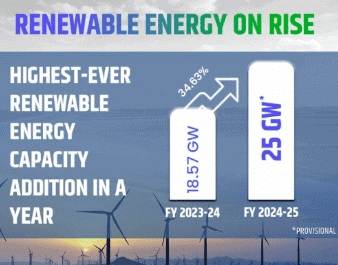UPSC Exam > UPSC Notes > PIB (Press Information Bureau) Summary > PIB Summary- 2nd April, 2025
PIB Summary- 2nd April, 2025 | PIB (Press Information Bureau) Summary - UPSC PDF Download
MEASURES TO IMPROVE INDIA’S GLOBAL RANKING IN TEXTILE MANUFACTURING
Context
The government is implementing various schemes to enhance India’s textile industry, ensuring global competitiveness, farmer support, and sustainability.
Government Initiatives to Promote Indian Textiles: Key Schemes and Initiatives
- PM MITRA Parks Scheme aims to create modern, world-class textile infrastructure.
- PLI Scheme focuses on large-scale manufacturing of Man-Made Fibre (MMF) fabric, MMF apparel, and technical textiles.
- National Technical Textiles Mission supports research, innovation, and market development.
- SAMARTH Scheme provides skill training for employment in the textile sector.
- Silk Samagra-2 promotes sericulture development.
- National Handloom Development Program supports the handloom sector.
- National Handicrafts Development Programme and Comprehensive Handicrafts Cluster Development Scheme aid handicraft artisans through marketing, skill development, and technology support.
- The government ensures Minimum Support Price (MSP) for cotton farmers to prevent distress sales.
Global Branding and Promotion
- Kasturi Cotton India has been registered as a trademark to enhance the identity of premium Indian cotton.
- The BHARAT TEX 2025 event in February showcased India’s textile industry, highlighting manufacturing strength, global competitiveness, and sustainability.
Question for PIB Summary- 2nd April, 2025Try yourself:What is the purpose of the PM MITRA Parks Scheme?
View Solution
India Achieves Historic Milestone in Renewable Energy Capacity Addition
Context
The country added 25 GW of renewable energy capacity in FY 2024-25, a 35% increase from the 18.57 GW added in the previous year.

Solar Power Growth
- The solar power sector led the growth, with capacity additions rising from 15 GW in FY24 to nearly 21 GW in FY25, a 38% increase.
- India surpassed 100 GW of installed solar capacity this year.
Expansion in Domestic Solar Manufacturing
- Solar module manufacturing capacity nearly doubled from 38 GW in March 2024 to 74 GW in March 2025.
- Solar PV cell manufacturing capacity tripled from 9 GW to 25 GW.
- India’s first ingot-wafer manufacturing facility (2 GW) started production.
- Investments of ₹41,000 crore under the PLI Scheme created 11,650 jobs.
PM Surya Ghar Muft Bijli Yojana
- The scheme benefited 11.01 lakh households by March 2025.
- Financial assistance was provided to beneficiaries to promote the adoption of rooftop solar systems.
Green Hydrogen Development
- Incentives of ₹2,220 crore were given for 1,500 MW per annum electrolyser manufacturing.
- Significant investments were made to boost Green Hydrogen production and support pilot projects for decarbonizing the steel and transport sectors.
- These initiatives include manufacturing electrolysers, producing Green Hydrogen, and introducing hydrogen-fueled vehicles along with refueling infrastructure.
PM-KUSUM Scheme Achievements
- 4.4 lakh solar pumps installed, a 4.2-fold increase from FY24.
- A significant increase was recorded in the installation and solarization of pumps under different components of the scheme.
- The total number of installed and solarized pumps crossed a major milestone, showing rapid progress.
- Financial expenditure for the scheme saw a sharp rise compared to the previous year.
Question for PIB Summary- 2nd April, 2025Try yourself: What was the total renewable energy capacity added by India in FY 2024-25?View Solution
The document PIB Summary- 2nd April, 2025 | PIB (Press Information Bureau) Summary - UPSC is a part of the UPSC Course PIB (Press Information Bureau) Summary.
All you need of UPSC at this link: UPSC
FAQs on PIB Summary- 2nd April, 2025 - PIB (Press Information Bureau) Summary - UPSC
| 1. What are the main challenges faced by India in improving its global ranking in textile manufacturing? |  |
Ans. India faces several challenges in improving its global ranking in textile manufacturing, including outdated technology, lack of innovation, and insufficient infrastructure. Additionally, there are issues related to labor costs, environmental regulations, and competition from other countries like Bangladesh and Vietnam, which have more favorable manufacturing conditions.
| 2. How can the Indian government support the textile manufacturing sector to enhance its global competitiveness? |  |
Ans. The Indian government can support the textile manufacturing sector by implementing policies that promote research and development, providing financial incentives for technology upgrades, and improving infrastructure facilities such as transportation and logistics. Additionally, creating favorable trade agreements and investing in skill development programs for workers can help enhance competitiveness.
| 3. What role does sustainability play in improving India's textile manufacturing ranking? |  |
Ans. Sustainability is becoming increasingly important in the textile industry, as consumers and businesses are more aware of environmental issues. By adopting sustainable practices, such as using eco-friendly materials, reducing waste, and ensuring ethical labor practices, India can improve its global image and attract international buyers who prioritize sustainability.
| 4. What initiatives have been taken by India to increase its textile exports? |  |
Ans. India has launched several initiatives to boost textile exports, including the Production-Linked Incentive (PLI) scheme that encourages investment in the textile sector, and the Technology Upgradation Fund Scheme (TUFS) to support modernization of manufacturing processes. Additionally, participation in international trade fairs and exhibitions helps Indian manufacturers showcase their products globally.
| 5. How does India's renewable energy capacity addition impact the textile manufacturing industry? |  |
Ans. The addition of renewable energy capacity in India can significantly benefit the textile manufacturing industry by reducing energy costs and enhancing sustainability. By utilizing renewable energy sources, textile manufacturers can lower their carbon footprint, comply with environmental regulations, and appeal to eco-conscious consumers, ultimately improving their market position globally.
Related Searches





















